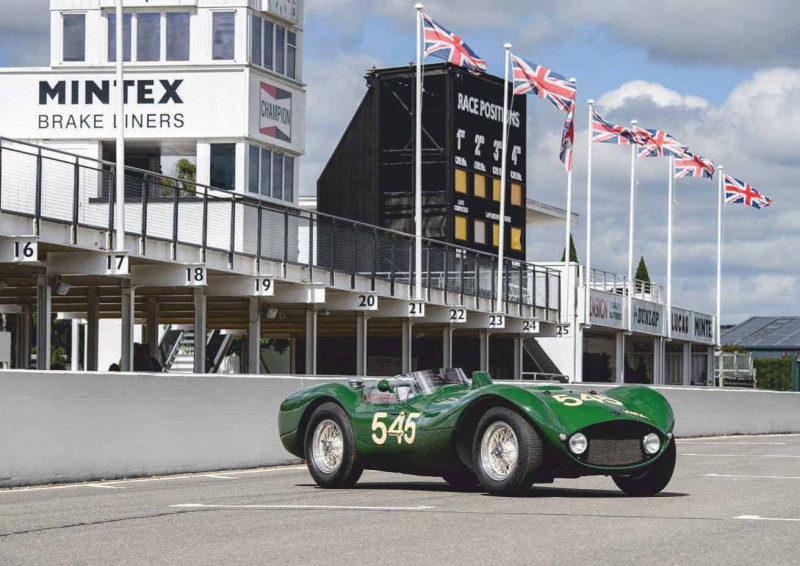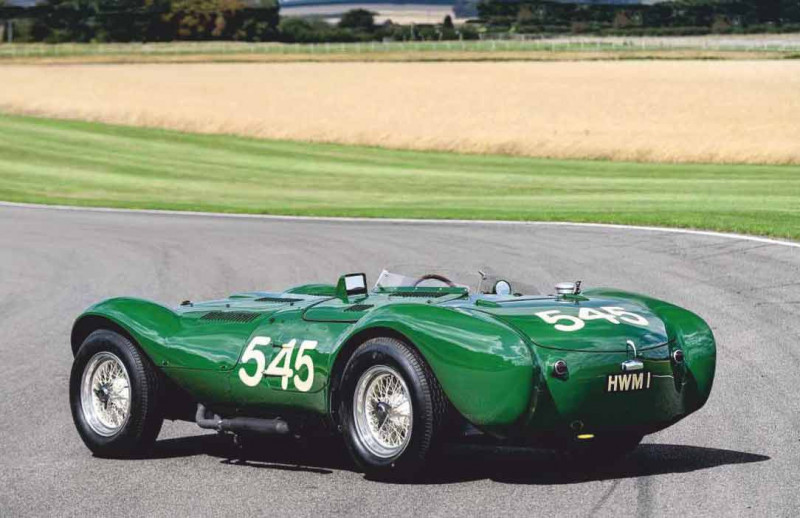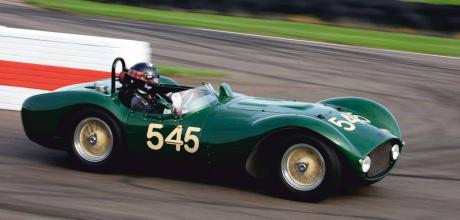1955 Jaguar HWM-1
Two cars have been 'HWM 1 The second was the last racer the company built… and it’s still competing. Sam Hancock tries it. Words James Elliott. Photography Tim Scott.
HWM 1 Most famous of the special HWM Jaguars
A GAME OF NUMBERS
Today, ‘personalised’ number plates are usually little more than vulgar adornments, tacky automotive bling that requires a cryptic crossword brain to decipher into anything meaningful. But in the heady post-war British motor trade boom they were a bold statement and sometimes a vital advertising hoarding. Manufacturers, racing equipes and dealers (many companies were all three back then) embraced them as a cheap way of adding class and memorability to translate into sales.

They were so prevalent that well-known cars, especially the burgeoning road-registered sports racers, often became identified by their number plates. Sometimes multiple cars achieved fame with the same number, these hand-me-down halo registrations transferred to the next bit of prime stock when the one that previously wore them was sold. Tony Crook at Bristol had 100 MPH, then there were Dick Protheroe’s CUT 7s and John Coombs ’BUY 1 and BUY 12 (‘buy one too’, he corrected me; even ‘Noddy’ wasn’t optimistic enough to think that a win at Goodwood would instantly translate into fleet sales). And then there was this, HWM 1.
'FAST CORNERS LIKE FORDWATER ARE NOW NEARLY FLAT, WITH JUST THE TINIEST LIFT TO TUCK THE NOSE IN AT THE APEX'
HWM epitomised those 1950s outfits. It had that trilogy of disciplines mentioned earlier: dealership (still is, actually, specialising in Aston Martins), race team and manufacturer. It settled in the same geographic area as so many others, the HWM standing for Hersham & Walton Motors. It may not have been immediately beside the A3 like the John Cooper Works or Alta, but it was definitely in the ‘corridor’.

The company had been founded immediately prior to World War Two by John Heath and his first wife Barbara, to marry together his various businesses. Almost immediately post-war, acquaintance and RAF war hero George Abecassis who, having inherited at 21, had been making a name for himself competing in Altas, suggested they join forces, The pair occupied the then-idle Vickers factory in Walton-on-Thames, which prior to requisitioning had been Bridge Motors and before that a film studio. HWM is still based at the same site today.
Thoughboth Heath and Abecassis were ex-public schoolboys (Bradfield and Clifton respectively, should such things matter to you) from well-to-do Surrey stock, and both had been disadvantaged in childhood (by divorce and death respectively), they were very different characters. Heath was an impatient, relentless, hands-on workaholic engineer who was famously way beyond frugal, making Abecassis seem almost Wodehousian in comparison. Both raced, but one purely as a driver, the other as ferociously determined team principal and mechanic.
The pair started racing in the late 1940s and by 1950 their Alta-powered single-seaters were running in Formula 2. A change in the regulations opened the door to F1 in 1954, but it proved fruitless and was quickly abandoned in favour of the Jaguar-powered sports racers.
Perhaps the two most remarkable facets of the HWM single-seater career were the incredibly low budgets they managed to compete on and the huge roster of driving talent employed. Nearly 40 racers drove HWMs in period; they ranged from young hotshoes needing a proving ground, such as Stirling Moss and Peter Collins, to seasoned greats such as Louis Chiron. Not to mention the legions of hire-drive heroes.

The first HWM 1, later to become YPG 3, was twin-tube chassis 1 08, a 1951 single-seater prototype, This sat unloved until Abecassis, perhaps inspired by customer Oscar Moore, decided to turn it into a sports racer in 1953, with the thrilling addition of an ex-factory Jaguar C-type engine on triple Webers and Weslake cams instead of HWM’s mainstay Alta four-pot. This car also established the HWM green that would become a familiar calling card and an important part of HWM 1 Mk2’s resuscitation. Abecassis pounded chassis 1 08 round the circuits near-constantly for two years, even replacing its fragile aluminium body with steel for the gruelling Mille Miglia. When it was sold to Ray Fiedling in 1956, HWM 1 was naturally succeeded by… HWM 1.
'WHEN IT WAS CREATED, NO-ONE COULD FORESEE THAT IT WOULD BE THE LAST RACING CAR THAT HWM EVER BUILT'
The incarnation of HWM 1 you see here is chassis 52-106, the most famous of all HWM sports-racers for all the right and wrong reasons. Conversely to the norm, its career started in tragedy and then brightened, in its second life becoming a constantly campaigned racer before ageing into a Historic racer that remains a force to be reckoned with to this day.
It was as different from its predecessor under the skin as it was to look at. Shrouding the 3.4-litre Jaguar twin-cam six was a dramatic body with gaping grille and high wheelwells stretching far above the bonnet, reminiscent of Donald Campbell’s Bluebird-Proteus CN7. More to scale would be an Aston Martin DB3S, with which there were also similarities. In that grille sat the headlamps, always a great look. Underneath was still the kite-shaped twin-tube chassis with outriggers, modified from that of the single-seaters. Suspension was by double wishbones at the front, de Dion tube at the rear and coil springs at both ends, while braking was by Alfin drums all round.
When it was created, no-one could foresee that it would be the last racing car that HWM ever built, That tragedy: John Heath became the only driver to die at the wheel of an HWM when, in the sunset of his racing career, he decided to return to the Mille Miglia in HWM 1 in 1956. It was, as these things tend to be, a real rush job to get the car ready, with little shakedown and development. Its first outing of any kind was with Noel Cunningham-Reid at Goodwood’s Easter Monday meeting, and it was clearly unfinished then.
It was the same at Oulton Park two weeks later, yet by 29 April HWM 1 was lining up in Brescia with Heath, reportedly out of sorts and having second thoughts, at the wheel. Fewer than 200 miles and three hours later, in torrential rain that prompted a flurry of crashes including two big ones at the same spot as Heath’s, HWM 1 slid off the road on a left-hander at Glorie di Mezzano. Heath was carted off to hospital and later died of his injuries, complicated by pneumonia. He was one of seven fatalities that year.
HWM 1 was rebuilt, stayed on the books and was works-campaigned, hire-driven and loaned out for a while. Its drivers included Cunningham- Reid and Peter Blond. But in 1958 a despondent Abecassis, who had quit racing himself and was winding down the company’s motorsport interests after Heath’s death, sold HWM 1 to Team Speedwell (comprising Monty Mostyn, Bill Smith, John Sprinzel and main driver John Bekaert) for £1500. It became a formidable and successful performer, securing ten wins in its first sprinting season. When Bekaert moved on to a Lister, a young ace called Alan Mann snapped up HWM 1 for £700, then raced it for two years before trading it in with legendary dealer Danny Margulies.
With many owners, including Kirk Rylands who kept it for more than 30 years, HWM 1 was inevitably modified over the years, not least to sort out its understeer, airflow to the triple Webers and underperforming brakes. By the time Rylands took it on in 1974, it was silver and cost nearly 10 times the £645 that Margulies had asked for it a decade earlier. Times had changed and HWM 1 changed with them.
Alfa Svengali Paul Grist acquired it in 2008 when Rylands’s long tenure came to an end. HWM 1 received a total rebuild to original specification, probably the second of its life, and a patinated BRG paint job. It passed through just one more owner before winding up with London dealer and broker Gregor Fisken, with whom it still resides.
The car is now returned to its 1956 Mille Miglia livery: the famous HWM green with white wheels, and that evocative race number, 545, which those familiar with the Mille Miglia will know was the 5.45am start-time at which Heath was flagged away.
Fisken famously likes to exercise his cars, and he continued HWM Is fine tradition by returning it to Goodwood for the first time in over 60 years in 2019. In 1957, Peter Blond raced it to fifth in the Sussex Trophy at the 77th Members’ Meeting; Fisken remarkably qualified HWM 1 on the second row in a D-type dominated grid, and was running in sixth when the race was red-flagged. Since then HWM 1 has triumphed in the Woodcote Trophy at the Silverstone Classic with Fisken and Martin Stretton and also at the Donington Historic Festival with Fisken and classic car consultant, writer and well-known hotshoe Sam Hancock. So, who better to tell us what HWM 1 is like to drive on the ragged edge?
ON TRACK IN HWM 1, with Sam Hancock
At six feet two inches, I don’t so much sit in HWM 1 as on it. With my legs wrapped awkwardly around the large, period-style steering wheel I wonder at first if this green goddess and I have any hope of a high-speed future together.
Fortunately, the old trick of simply dispensing with the seatbase entirely, to sit instead directly on the floorpan, solves the problem and soon enough I am under way. Quite comfortably, too, dare I say; my eyeline is now peering just over the stunted aero screen and along the handsome bonnet flanks to the road ahead.
If you’ve any prior experience of cars propelled by Jaguar’s famous 3.4-litre (or, indeed, larger) straight-six engines, HWM 1 would feel immediately familiar. A rorty yet linear power delivery provides a sweet punch at the lower end of the rev range which, while not exactly a knock-out blow, is certainly an effective jab from Goodwood’s slower apexes.
But it’s the higher octaves of this power plant that I enjoy most. Unencumbered by excessive chassis mass in this lightweight sports racer, the XK motor really sings with no discernible plateau in power even up to — and beyond — 6000rpm.
Rowing through the gears is a joy, particularly when downshifting as the well-tuned Webers respond tightly to the rev-matching instructions of my right foot, the gear lever juts forward in an almost handbrake-like fashion that feels a little odd at first, but it’s right where you need it to be once you’re up to speed.
At first, though, HWM 1 feels a little too soft, the ride is comfortable, certainly, and would likely be well suited to a road tour or rally, but through Goodwood’s more daunting high-speed turns I need a more stable platform to work with.
Fortunately owner Gregor Fisken has invited feedback, so I suggest a few small adjustments. Preparer David Brazell and his merry band of technicians are well up for the task and make light work of some spring changes. Soon enough, the handling is transformed and the HWM comes alive. Dialling the balance in further with a few additional tweaks, I develop a confidence that really allows me to attack the track.
Fast corners such as Fordwater are now nearly flat, with just the tiniest lift to tuck the nose in at the apex. And without the roll oversteer that was bugging me earlier, I can carry far more speed into the slower apexes of Lavant and the chicane.
Once loaded, the car now takes a ‘set’ and stays there — happy and content in a shallow drift, unsettled only by added throttle. But the downside to this new-found mid-corner stability is that the front end becomes a little numb on corner entry. Fortunately, HWM 1 responds well to a gentle trail-brake, just enough to keep the front loaded while turning into the corner.
I need to encourage it further, though, so occasionally I try a light ‘shove’ on the steering in the hope of getting the car to pivot early, straighten up and facilitate an early return to power. It works to a degree but it’s not exactly precise. Ah, the limitations of L-section racing Dunlops...
What’s important, however, is that HWM 1 now reveals a fabulous poise and balance. It’s not so stiff as to rattle your teeth, but it feels rigid enough to cope with the cornering loads of the high-speed turns and the swift direction changes required at St Mary’s and the chicane.
Soon enough, the decreasing lap times reflect this car’s clear potential. Naturally, I have shamelessly added myself to Gregor’s expansive list of willing co-drivers. He has proved that it can take on D-types, after all.
Main image and below Driving HWM 1 at Goodwood allowed Hancock (in blue) and Fisken to set it up properly, which paid off at Donington.
Clockwise, from above Jaguar 3.4-litre engine has hot Weslake camshafts; lankHancock had to remove cushion of upright,patinated seat; cranked- forward gear lever looks more like a handbrake.
Above and below On the start-ramp of the 1956 Mille Miglia and ready for the off at 5.45am, with no sign yet of the torrential rain that would wreak havoc; during scrutineering at Piazza Vittoria.


